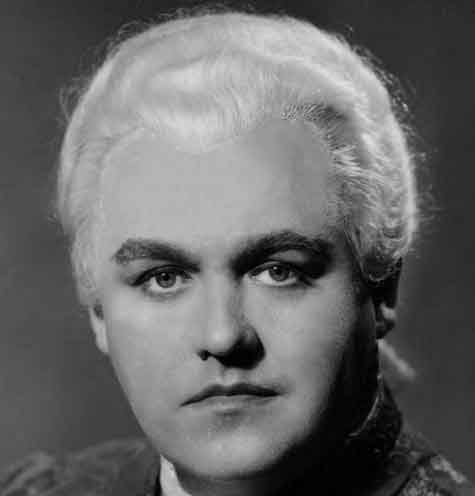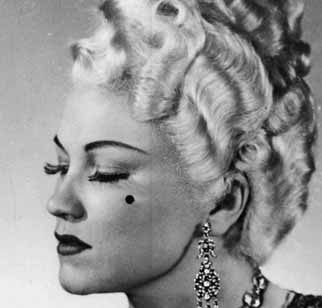Key Word Search
Multi-Field Search
Browse
Repertory Report
Performers Report
Contacts
Met Opera Website
New Production
Manon Lescaut
Metropolitan Opera House, Wed, November 23, 1949
Debut : H. M. Krehan-Crayon
Manon Lescaut (69)
Giacomo Puccini | Luigi Illica/Giuseppe Giacosa/Marco Praga/Ruggero Leoncavallo
- Manon
- Dorothy Kirsten
- Des Grieux
- Jussi Björling
- Lescaut
- Giuseppe Valdengo
- Geronte
- Salvatore Baccaloni
- Edmondo
- Thomas Hayward
- Innkeeper
- George Cehanovsky
- Solo Madrigalist
- Jean Madeira
- Dancing Master
- Alessio De Paolis
- Sergeant
- Clifford Harvuot
- Lamplighter
- Paul Franke
- Captain
- Osie Hawkins
- Conductor
- Giuseppe Antonicelli
- Director
- Herbert Graf
- Designer
- H. M. Krehan-Crayon [Debut]
Manon Lescaut received nine performances this season.
Review 1:
Review of Cecil Smith in Musical America
Puccini's "Manon Lescaut," absent from the Metropolitan Opera for almost twenty years, was revived as the second production of the season, on the evening of Nov. 23, in a non-subscription performance sponsored by the Metropolitan Opera Guild. This fall being the 25th anniversary of Puccini's death, the Metropolitan paid homage to his memory by commissioning new settings by Krehan-Crayon, a designer for television who here undertook his first assignment for the opera house. The title role was sung by Dorothy Kirsten, who made a youthful success in the part at the City Center five years ago. Jussi Björling appeared as Des Grieux, and Giuseppe Valdengo as Lescaut. Giuseppe Antonicelli was the conductor, and Herbert Graf the stage director.
The Metropolitan's neglect of "Manon Lescaut" for two decades is entirely incomprehensible. Puccini himself placed a high valuation on the score, and told Giulio Gatti-Casazza before its premiere that he would give up composing for the operatic stage if his third piece followed "Edgar" and "Le Villi" into limbo. Far from repeating the calamitous history of those two earlier efforts, "Manon Lescaut" won immediate success in Italy. It was then hailed with enthusiasm in New York when Lina Cavalieri and Enrico Caruso impersonated the dejected leading couple for the first time on Jan. 18, 1907. It was in the repertory much more than it was out of it in the years between 1907 and 1923, and it returned for a three-year period from 1927 to 1930, when Frances Alda and Lucrezia Bori shared the title part (Mme. Alda sang her farewell performance in this opera on Dec. 28, 1929), and Beniamino Gigli was the customary Des Grieux. Then suddenly the opera disappeared from sight and sound, never to return-except for its brief reprieve at the City Center in 1944--until this fall.
It would be hard to find a parallel case of the abandonment of so fresh, vital, and well-written an opera after it had attained and maintained considerable popularity. For "Manon Lescaut" is not, by any means, a weak item in the Puccini catalogue, or, for that matter, in the entire list of post-Verdi Italian operas. In many ways its expressive range is wider than that of any of the three Puccini perennials, except perhaps "Madama Butterfly." Never again until he sought to expand his musical style in his last, unfinished opera, "Turandot," did the composer permit himself so experimental and uncategorical an attitude toward operatic composition. The characteristic Puccini warmth suffuses the whole score of "Manon Lescaut;" the spontaneous inflections of heartfelt emotion are in it, but not the purely theatrical clichés that so often impart a mechanical character to passages in the later operas. It may be the very eclecticism of the "Manon Lescaut" music that has kept it from receiving the whole-hearted approval that was from the first accorded to "La Bohème," with its economy of device and its exclusive preoccupation with a single small area of pathetic experience; to "Tosca" with its swift libretto and melodramatic musical vocabulary; or to "Madama Butterfly," with its Oriental embellishments and its shrewdly planned musical and theatrical rise from a coy and girlish beginning to a finale of genuinely tragic scope.
Of the three more familiar operas, "Madama Butterfly" is the one closest in character to "Manon Lescaut," if one ignores the Orientalisms. The mounting dramatic line of "Manon Lescaut," while set forth largely in terms of more static musical episodes, presages the psychological structure of "Madama Butterfly." The first two acts (except for a few such passages in the second act as Manon's aria, 'In quelle trine morbide,' and the histrionics that result from the discovery by Geronte, Manon's aristocratic lover, that she has been having clandestine rendezvous with Des Grieux) are chiefly developed musically out of decorative eighteenth-century imitations so light in tone as to border upon the province of operetta. The third act, however, with its depiction of the embarkation for America of Manon and the other fallen women, and its final climax as Des Grieux successfully implores the Captain to be permitted to go along, attains great theatrical heights; Des Grieux' passionate outpouring sounds out to the gallery as forcefully as Edgardo's denunciatory measures after the sextet in "Lucia di Lammermoor." And the unhappy finale, placed in "a desert near New Orleans" by a librettist signally uninformed about geography, provides a plaintive conclusion rivaling that of "La Bohème."
To this admirable opera, which ought to stay in the repertory now, that it has come back, Dorothy Kirsten contributed the outstanding performance of her Metropolitan career thus far. In the first act a bit of the Hollywood patina that tarnished her Fiora last season still clung to her characterization. But with 'In quelle trine morbide,' sung beautifully, though somewhat too fast, a note of emotional urgency came into her voice, and her acting relaxed into complete genuineness. From this point forward her performance grew steadily more impressive, until the final act revealed her, for the first time, as a genuine tragic singing-actress, capable of losing herself in the spirit of her part, and of touching the audience deeply. All evening long her voice was radiant, and her vocalization was as nearly perfect as any to be heard at the Metropolitan.
Mr. Björling's merits were entirely vocal, since the art of acting does not fall within his purview. From the start he sang with exemplary plasticity of phrasing and sensitivity of nuance, though his voice was not in its most resonant condition. In his big moment at the end of the third act his tone took on the brightness it had largely lacked until then, and he propelled the music across the stage apron with a degree of force and passion that won him an ovation.
Mr. Valdengo sang easily, if rather heavily and unimaginatively, as Lescaut. He failed, however, to get much out of the character. As Geronte, Salvatore Baccaloni sought to create a believable figure, and managed to do so whenever his ingrained mannerisms did not dispel the illusion. The other singers, all sufficiently capable, were Jean Madeira, as the Musician who leads the group of madrigal-singers in the second act; Thomas Hayward, as Edmondo; Alessio de Paolis, as the Ballet Master; George Cehanovsky, as the Innkeeper : Clifford Harvuot, as the Sergeant; Paul Franke, as the comic Lamplighter; and Osie Hawkins, as the Captain. Mr. Antonicelli conducted in a fashion that preserved the general outlines of the score without providing any remarkable revelations.
Visually, the production deserves, in all charity, to be brushed over lightly. Mr. Graf's handling of the chorus had little to recommend it, and for the rest, the individual artists were apparently left largely to their own devices and conceits. The designs of Krehan-Crayon may have been new in physical fact, but except for the third-act wharf scene, which had a certain pictorial value, nothing older or more sterile in the way of design can be seen in the Metropolitan's most venerable storehouse productions. It was a grievous disappointment to discover that the management, ill able to afford any new settings whatever, should have frittered its money away on so dull and repetitious a type of investiture.
Review 2:Review of Irving Kolodin in the Sun
"Manon Lescaut" Heard in Metropolitan Revival
Some inflammable materials were exposed by the Metropolitan at the Wednesday evening revival after nineteen years of Puccini's "Manon Lescaut," but whenever they threatened to burst into audience-consuming flame, the asbestos hand of Giuseppe Antonicelli, at the conductor's desk, damped them down. There was, in the first place, the handsome, sensible and generally tasteful designs by the Czech artist, Krehan-Crayon; a superior singing effort by Jussi Bjorling, and more than good ones by Dorothy Kirstin, Giuseppe Valdengo and Salvatore Baccaloni. It was, in a sense, a production all dressed up, but with no place to go.
As an ensemble effort - staging (Herbert Graf's), singing and settings - this ranks high among those Edward Johnson has given us. Somewhat like a salad without garlic, it was all greens, and no spice. Miss Kirsten's Manon Lescaut first attracted attention to her at the City Center (where I did not see it); but it has surely gained in vocal thrust and acting poise since then. The security of her production, the courage and ease with which she attacks high tones are impressive - and let no one regard her musicianship or earnestness lightly, either.
Beautiful in appearance and gracious in motion (save when high heels impeded her staggerings around the Louisiana plain of the last act), Miss Kirsten's Manon almost deserved the bouquet of roses thrown to her after the second act by a disinterested spectator named Frederick Schang (her manager). The managerial gesture would have been better expressed by an ear of corn, for it is against the house rules to serve the "vegetables of fame" in public.
There were no roses for Bjorling's Des Grieux (Derby time is still in May), but handsful of applause for his strong, steady and resourceful tenorizing. His first two acts were under par in color and resonance, but the third-act climax was beautifully handled, and the tone he pumped into the fourth-act duet made one realize why this was a fruitful role for Caruso. Valdengo's expressive Lescaut and Baccaloni's artful Geronte deserve more than the tag-end mention permitted in these lines, as do virtually all the subsidiary characters. The interest of Puccini's pre-"Bohème" - "Tosca" - "Butterfly" score may be intermittent, but it would be more seizing on the spectator's attention were Antonicelli to value Puccini more highly than the good will of his singers. The Guild was host to the audience and a delegation from the U. N. including Messrs. Romulo and Vishinsky.
Photograph of Dorothy Kirsten in the title role of Manon Lescaut.
Photograph of Jussi Björling as Des Grieux in Manon Lescaut.
Search by season: 1949-50
Search by title: Manon Lescaut,
Met careers
- Giuseppe Antonicelli [Conductor]
- Dorothy Kirsten [Manon]
- Jussi Björling [Des Grieux]
- Giuseppe Valdengo [Lescaut]
- Salvatore Baccaloni [Geronte]
- Thomas Hayward [Edmondo]
- George Cehanovsky [Innkeeper]
- Jean Madeira [Solo Madrigalist]
- Alessio De Paolis [Dancing Master]
- Clifford Harvuot [Sergeant]
- Paul Franke [Lamplighter]
- Osie Hawkins [Captain]
- Herbert Graf [Director]
- H. M. Krehan-Crayon [Designer]

